Co-processed excipients for direct compression of tablets
Authors:
Aleš Franc; David Vetchý; Pavlína Vodáčková; Roman Kubaľák; Lenka Jendryková; Roman Goněc
Published in:
Čes. slov. Farm., 2018; 67, 175-181
Category:
Review Article
Overview
Tablets are the most frequently employed dosage form. Their advantage lies in their availability, easy administration, good stability, and low price. The easiest technology to produce tablets is direct compression, even though the use of the method requires overcoming many obstacles, mainly related to content uniformity and variation of mass, disintegration, dissolution, and radial hardness of tablets. “Co-processed excipients”, containing commonly processed blends of fillers, binders, disintegrants, lubricants, and other excipients are more and more widely used nowadays. These mixtures are manufactured by various technologies, chiefly by spray-drying, fluid bed granulation, wet granulation, melt granulation, dry granulation, and co-crystallisation. This review article lists excipients used usually to constitute co-processed excipients, technologies, and commercially available co-processed excipients for direct compression.
Keywords:
co-processed excipients, direct compression, blends, tablets, physical characteristics
Introduction
Since the 1960s, direct compression technology has been increasingly used in tablet manufacture. The principle lies in weighing components followed by blending and tabletting. The advantages include chiefly a limited number of manufacturing steps, a shorter time of manufacture, a lower energy demand, and thus reduced costs, lower variability of the production, improved stability of the active substance (API), shorter disintegration and dissolution of manufactured tablets, easier validation of the production, and lower risk of microbial contamination1).
Due to the absence of granulation, the possibility to manufacture tablets with a high content of active ingredients (API) is limited. This is called “low dilution potential”. The API has to be both standard and of high quality to allow a high quality of powder (tabletting) blend. During the mixing process particles often segregate, which may have negative impact on content uniformity. Powder blend has worse flow properties; this may lead to higher weight variability. Furthermore, powder blend has a higher surface area, requiring the use of a larger amount of the lubricant. The tablets may have lower mechanical resistance, which can be observed during stress testing2).
To overcome these disadvantages, the producers decided to develop maximum quality direct compression excipients. Firstly, they introduced better flowing and better compressible mono-excipients3). Secondly, co-processed excipients (CPE) were put in practice. CPEs contain mostly carriers, binders, and disintegrants, sometimes also surfactants or lubricants. Other substances may be contained as well, e.g. substances for controlled release, flavours, colours, antioxidants4) or even the active substance itself5).
In fact, CPEs are solid dispersions manufactured by various granulation processes: spray-drying (SD), co-melting (Co-MELT), co-crystallization (Co-CR), co-milling (Co-MILL), etc. These dispersions have better physical-chemical properties than powder blends manufactured by blending alone. CPEs are characterised by standardized particle size distribution, similar and more spherical particle shape, high density, and high porosity; this results in improved flow and compressing properties as well as higher dilution potential. The required amount of the lubricant is also lower. With the possible exception of API, particular components building solid dispersions do not segregate anymore; the tablets have better disintegration and often better bioavailability. The whole process is less time-consuming6).
In the 2000s, oral dispersible tablets (ODT) have started to play an important role in pharmaceutical technology. Furthermore, some APIs are absorbed as soon as in the oral cavity and reach circulation without the first-pass effect in the liver that follows standard oral administration; the onset of effect comes sooner and is higher. CPE in combination with direct compression proved to be a suitable road in ODT production. CPEs for ODT are usually non-hygroscopic and mask unpleasant flavours satisfactorily7). Beside CPEs for ODT, CPEs for controlled-release drugs entered the market, too. These CPEs contain excipients that form insoluble and swelling or slowly eroding matrices and which were used in granulation and direct compression processes originally. CPEs for controlled release are supposed to lead to standardised dissolution profiles and improved robustness of the production8).
The aim of this article was characterize parameters (composition, technology and evaluation) of selected commercial CPEs accompanied by scans from an electron microscope (JCM-6000 NeoScope™ Benchtop SEM, JEOL, USA) depending on the used technology.
Most frequent excipients used in CPE
Fillers
The two most frequent fillers are saccharides and inorganic substances in diverse modifications. Inorganic substances include calcium or magnesium sulphate or carbonate. ODT and pastilles contain well-soluble saccharides and polyoles, e.g. saccharose, mannitol, sorbitol, or xylitol. Due to its price, fructose is less popular despite a high sweetening effect. Microcrystalline cellulose (MCC) has excellent compressing properties and acts as a dry binder; furthermore, due to its porous structure, it acts also as a capillary disintegrant. Starch stands on the boundary between a filler, binder, and capillary and swelling disintegrant9). An example of CPE containing both organic and inorganic filler is Avicel® DG (FMC). Because of a high content of MCC combined with calcium phosphate, it is suitable for dry granulation as well10).
Binders
When using direct compression, it may be difficult to process binders in low concentration into powder blends. Low concentration, irregular particle shape, and poor flow properties are significant obstacles that stand in the way of blending. Furthermore, binding properties cannot manifest themselves properly in dry state. On the other hand, when using these substances as CPE components, they can be dissolved or dispersed in a liquid, impregnating or penetrating the whole mixture evenly. Produced CPE is both uniform and has improved binding properties.
These binders include substances of natural origins, e.g. guma guar or dextrin; semi-synthetic substances, e.g. carboxymethyl cellulose (CMC), hydroxypropylmethyl cellulose (HPMC), hydroxyprolyl cellulose (HPC); and synthetic polymers, e.g. polyvinyl alcohol (PVA) and povidone (PVP)11). An example of CPE manufactured by wet granulation (WG) is Compactcel® (Bioground), containing PVP, HPC, and CMC. Compactcel® is added as the dry binder to powder blends to increase compressibility and hardness of tablets that contain a higher share of API12). Composition of individual CPE is described in Table 1.
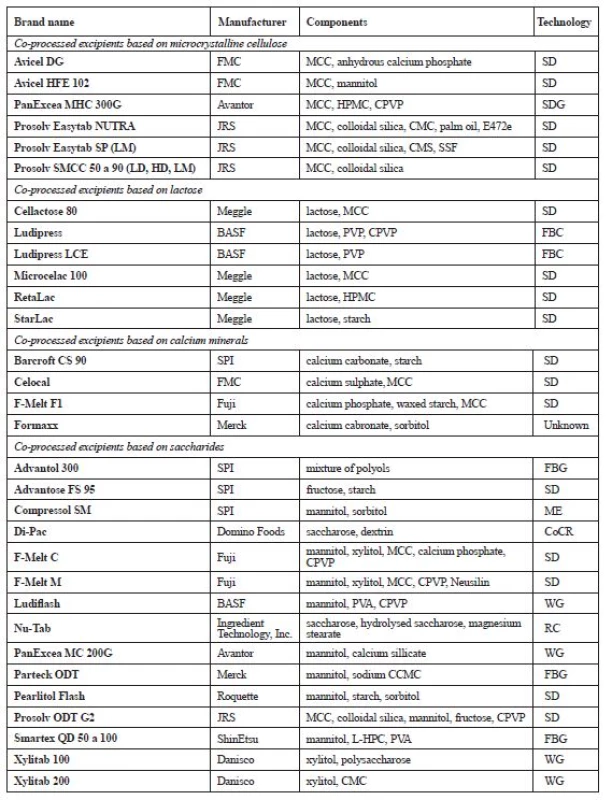
Disintegrants
Besides capillary-acting substances mentioned above, disintegrants include “superdisintegrants”, e.g carboxymethyl starch (CMS), crosscarmellose (SCMC), crosspovidone (CPVP), and low substituted hydroxypropyl cellulose (L-HPC), which have a strong swelling effect8), as well as inorganic substances, e.g. colloidal silica and magnesium aluminometasilicate that both improve hardness and disintegration of tablets by the mechanism of quick hydration and have antistatic and antiadhesive effects. Magnesium aluminometasilicate (Neusilin®) is contained in F-Melt® M, together with mannitol, xylitol, MCC, and CPVP. This quickly-disintegrating CPE is used in ODTs13). Composition of individual CPEs is described in Table 1.
Lubricants and surfactants
Usually, CPEs do not contain common lubricants, e.g. salts of fatty acids with magnesium or calcium because these lubricants are poorly soluble and dispersible in water and are not readily processed in dispersions. If CPE contains some lubricant at all, mixtures of oils and surfactants or surfactants alone are used; these substances have the ability to improve the wettability of API and thus its bioavailability. Examples include sodium stearyl fumarate (SSF), various types of saturated fat, silicone-coated starch, and fatty acid esters. Their lubricant efficacy is relatively low and the manufacturers suggest admixing a standard lubricant to the blend10). The only CPE so far that uses lubricant properties of magnesium stearate added in solid state is NU-TAB® (Ingredient Technology, Inc.). Beside saccharose and hydrolysed saccharose, it contains only a small amount of magnesium stearate; in theory, another lubricant is not necessary. SSF processed by standard dispergation technology is contained in Prosolv Easytab® SP (JRS), where it stands side by side with MCC, CMS, and colloidal silica to build lubricated CPE14). Composition of individual CPEs is described in Table 1.
Excipients for controlled release
Commercially available CPEs for controlled release contain e.g. highly substituted HPMC or carrubin to form matrix systems. Swellable HPMC is responsible for the formation of a gel coat around the tablet, which causes the API to diffuse slowly into the surrounding environment. Examples include RetaLac® (Meggle) that contains HPMC and lactose15). Systems based on acrylate polymers are being developed16). Composition of individual CPEs is described in Table 1.
Technology of preparation
CPE technology is based on the fact that a mixture of individual substances is turned into monodispersion that is listed as new entity in pharmaceutical technology because it has a new name and exclusive physical chemical properties. Regulatory authorities approve usually this new entity as a separate excipient. The technology is usually based on dissolving or dispersing individual excipients in liquid, which is removed subsequently; solid dispersion, solid solution, co-crystals, or mixture of these are formed. Another possible way to prepare CPE is a change of consistence, when one of the substances melts or forms a eutectic mixture that is able to dissolve or disperse the other substances if they are present. After cooling, a solid dispersion is formed without need to remove any liquid from the system6).
Spray drying
SD is the most widely used technology in CPE preparation. The principle of the process is based on drying the solutions, rarely emulsions or suspensions of substances (excipients) in fluidized bed in a spray-dryer. This method leads to formation of spherical solid dispersion powder that has good porosity, a relatively good particle size distribution and shape uniformity, with good flow and compressibility properties. Tablets manufactured from such dispersion tend to disintegrate easily. The method has two major disadvantages: it is highly power-consuming and a technical excipient – one or more liquids – has to be used17). Many brands of CPE for direct compression are manufactured by SD, e.g. MicroceLac® 100 (Meggle) that contains lactose and MCC in its spherical particles18). Composition of individual CPE is described in Table 1 and Figure 1.
a) Cellactose® 80, b) MicroceLac® 100, c) RetaLac®,
d) StarLac®
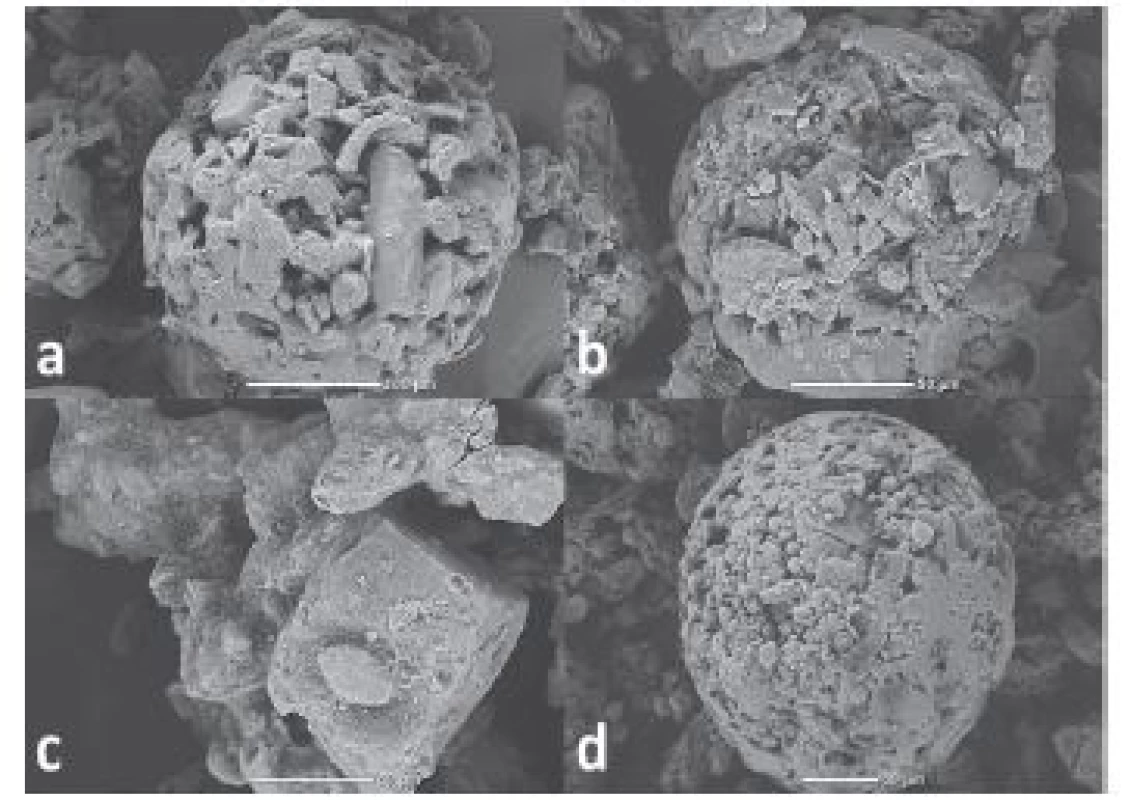
Fluid bed granulation
Fluid bed granulation (FBG) is likely the second most frequently used method to produce CPEs. The process is based on spraying the solutions, rarely emulsions or suspensions of individual excipients on a solid material (powder or powder blend) in a fluid bed, using chiefly top spraying. If the substance is sprayed on the solid particles with a defined shape structure, the process can be described also as fluid bed coating (FBC). FBG results in a granulate, FBC to coated microparticles. Combination of SD a FBG is spray drying granulation (SDG). This method transforms solution or suspension into dry particles that can be dried to spheres in a wide drying range before they are consequently granulated by a binder liquid in one step.
Particles obtained by both FBG/FBC/SDG and SD are similar in shape; however, the former have sometimes lower sphericity, a less regular particle size distribution and worse flow properties. This is caused by the fact that during fluid bed processes, no morphologically uniform monodispersion is formed as the carrier does not undergo significant changes and retains its difference in the resulting particles19). CPE prepared by FBC include Ludipress® (BASF) containing lactose, PVP, and CPVP20). When combined with a suitable retarding excipient, e.g. Kollidon SR, Ludipress® can be used as the filler in controlled-release tablets as well21). Composition of individual CPE is described in Table 1 and Figure 2.
a) Advantol® 300, b) Ludipress® LCE, c) Smartex® QD 50,
d) Smartex® QD 100
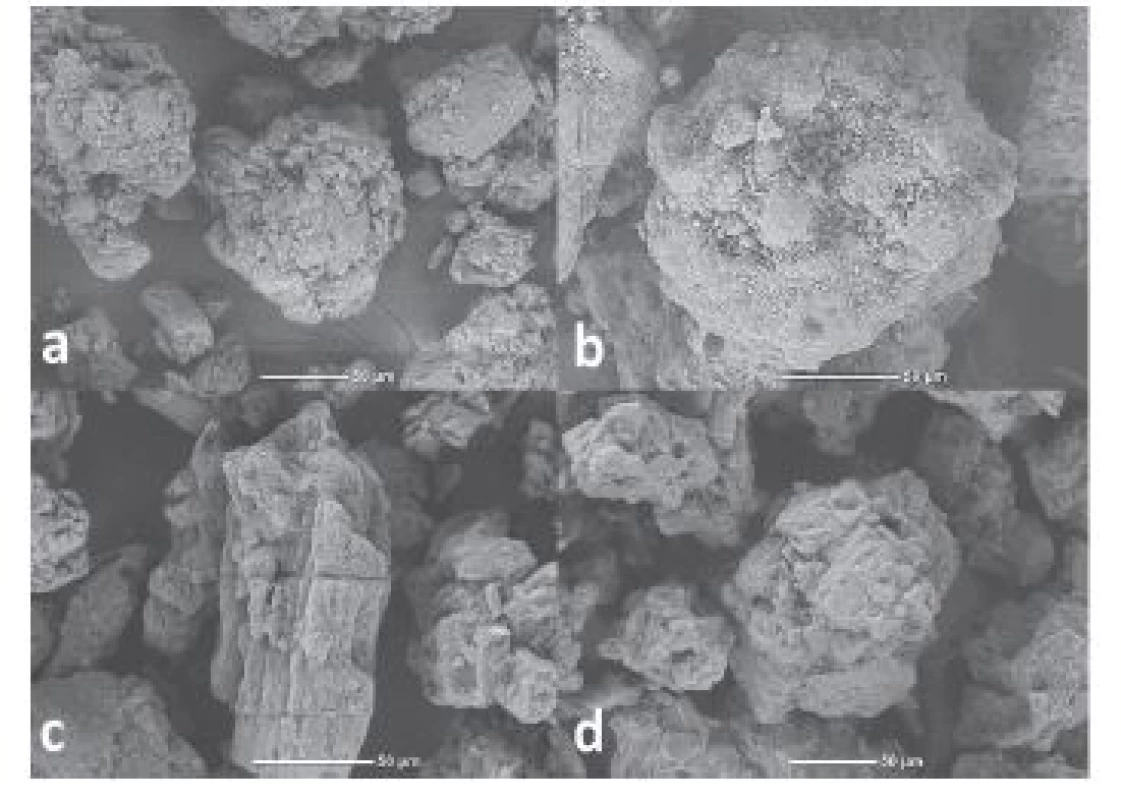
Wet granulation
When WG is used to prepare CPE, the process is based on the formation of wet dispersion from individual excipient powders and wetting liquid, drying and sometimes milling. Dried dispersion is usually sieved, which leads to particles with a medium density, a less regular shape, a lower sphericity, a lower porosity, and worse flow properties when compared to particles prepared by SD or in fluid bed22). Nevertheless, compressibility is the same or better. The advantage of this method is that it is easily available and it can be used for various purposes; furthermore, individual components do not have to be dissolved or dispersed in the granulation liquid and the total amount of liquid is much lower than in spray-drying or fluid bed23). CPE produced by WG include Compactcel® SIL (Bioground) containing PVP, HPC, CMC, and colloidal silica. Compactcel® is added to mixtures for direct compression as the dry binder; it can not only improve compressibility and hardness of tablets, but, due to silica, increases disintegration11). Composition of individual CPE is described in Table 1 and Figure 3.
a) Ludiflash®, b) Xylitab® 100
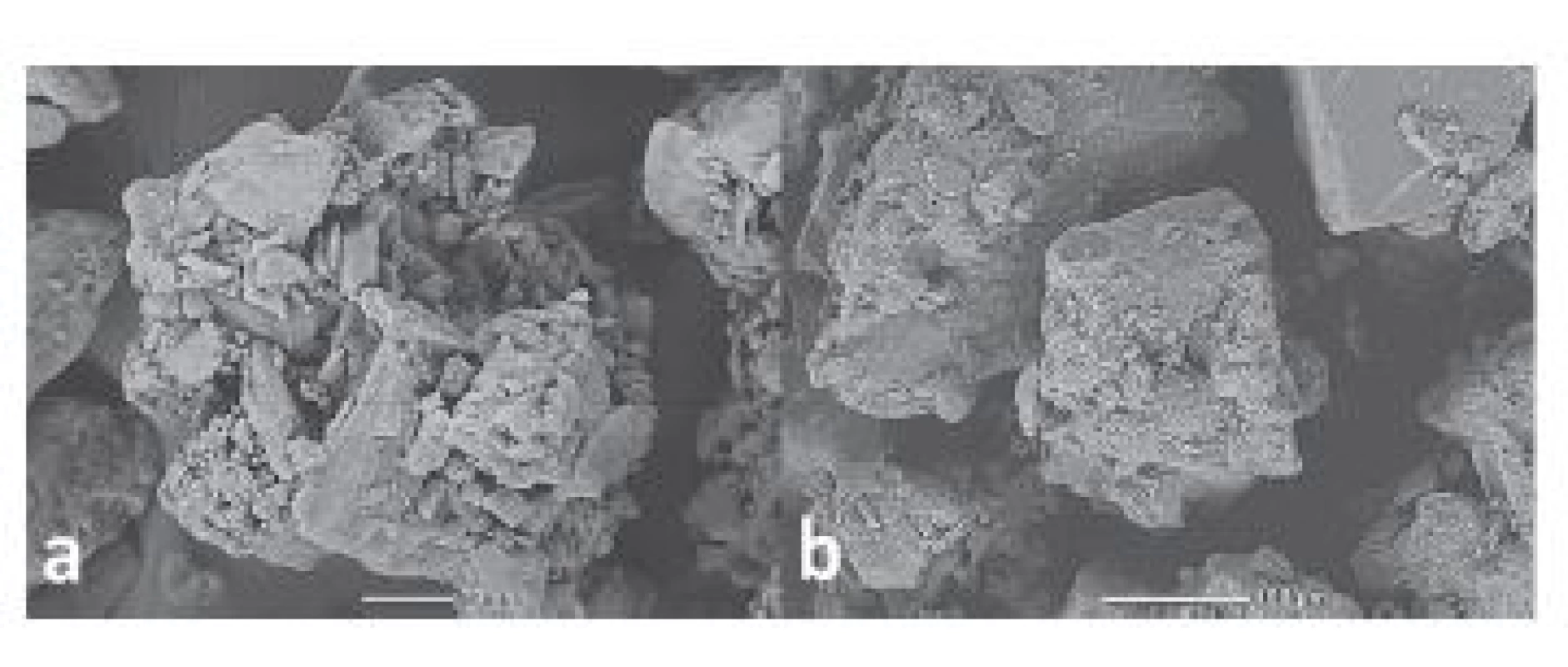
Melt granulation
This progressive method is based on the formation of a solid dispersion from individual components (powders or powder blends) when at least one component of the mixture melts and cools during the mixing which leads to mixed granules. If particular aggregates form without the need for extrusion, the process is described as melt granulation. If the granules form only during the extrusion, the process is described as melt extrusion. In both cases, solidified granules can be sieved to achieve desired particle size distribution. Melt granulation (MG) or extrusion (ME) is advantageous because it does not require the use of liquids. However, some substance with a low melting point has to be used. For melt granulation, “one pot” granulators with their own heat source can be used; similarly, for melt extrusion, extruders with their own heat source are necessary. A granulate produced by MG has similar properties as a granulate produced by wet granulation, while a granulate produced by ME has a more uniform particle shape24). CPE produced by melt extrusion contains Compressol® (SPI) manufactured by Co-MELT of mannitol and sorbitol. It has good flow properties, improved compressibility, and lower hygroscopicity than mixture obtained by mere mixing of both components. Compressol® is suitable for the production of ODT20). Composition of individual CPE is described in Table 1 and Figure 4.
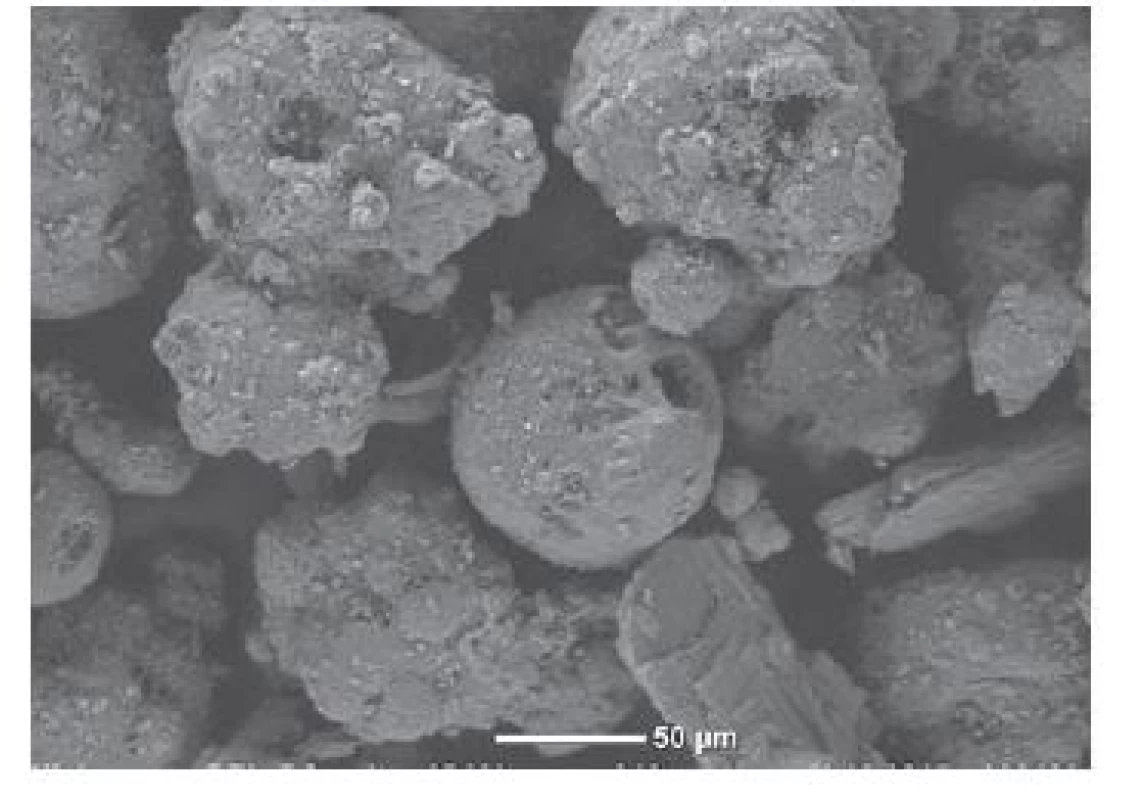
Dry granulation
Roller compaction (RC) is the most frequently used type of dry granulation (DG). The principle lies in processing the solid components (powders or powder blends) into coarse granules, using rotating rollers. The powder gets in between the rollers where it is compressed into compacts which are then milled to form granulated powder that has usually a higher density and a less regular shape than CPE prepared by any other method mentioned previously. The granulate has also poorer flow properties and lower compressibility. In some cases, the hardness of tablets is improved because of wedging of irregular shapes. Rare advantages of rotary compaction include the absence of any liquids or wetting solutions and the possibility to process large amounts of powder at once. However, the whole process is costly and requires specific equipment24). CPEs produced by rotary compaction include NU-TAB® (Ingredient Technology, Inc.) mentioned above where magnesium stearate is processed into the CPE in solid state. When compared with monocomponent sugars, the CPE has better flow and compressibility properties and it can be used to manufacture pastilles25). Composition of individual CPE is described in Table 1.
Common crystallisation
Co-CR which is used e.g. in chemical industry in the production of poorly soluble substances can be used to produce CPE as well. The principle lies in the formation of common crystals of at least two substances26). A co-crystal can be defined as a stoichiometric multi- component entity of host-guest type; individual substances are usually solid at room temperature. Specific properties of co-crystals are more suitable than those of the mixtures of individual crystals. Co-crystals can be prepared by various technological processes, e.g. Co-CR out of solution, Co-MILL, crystallisation out of Co-MELT, etc.27). Co-crystal CPE include DI-PAC® (Domino Foods) containing saccharose and maltodextrin crystallized out of common solution. These co-crystals have lower hygroscopicity, good flow properties, good compressibility and hardness of resulting tablets28). Composition of individual CPE is described in Table 1.
Other methods
Recent methods are represented by spray-drying granulation that combines SD and FBG. Firstly, spray-dried powder is formed, then, after transport to fluid bed, FBG ensues. In fact, the principle is based on two connected fluid beds29). Other methods used for preparation of CPE “in house“ include common precipitation, common evaporation of solvent, and common dehydration. However, commercially available CPE do not list these manufacturing procedures (see Table 1)30).
Impact of use of CPE on physical properties of tablets
The assessment of quality of particular CPE is advertised by their manufacturers by comparing the properties CPE alone and resulting tablets. The most important ones include content uniformity, mass varia- tion, disintegration, dissolution, mechanical resistance, humidity, and stability31).
Content uniformity
The best way to mix uniformly various substances is to use particles of a similar shape (spherical if possible), a similar density, a similar size, and a similar ratio in the blend32). Some producers offer CPEs with various density and particle size distribution; e.g. Prosolv® SMCC (JRS), i.e. spray-dried blend of MCC and colloidal silica (silicified MCC) with improved compressibility properties, is available in four types, combining two types of mean particle sizes (50 and 90 µm) and two types of density (low – LD and high – HD)33).
Mass variation
Good mass variation can be achieved when the tabletting blend has good flow properties. These properties are defined by parameters calculated from density, i.e. Hausner ratio, Carr compressibility index, flow rate and angle of repose. Generally, CPEs for direct compression have better flow properties than mere mixtures of substances they are prepared from11, 34).
Disintegration and dissolution
The dissolution test is very important because it can predict liberation and bioavailability. In development of ODT, disintegration plays also a major role, European Pharmacopoeia sets the limit at 180 s, US Pharmacopoeia at 30 s. In particular, CPEs, besides the composition, physical properties like surface area or porosity characterise the behaviour of the blend35). Logically, more porous material has better wettability, with positive impact on disintegration as well as dissolution. CPEs that were developed to improve dissolution in the oral cavity include Ludipress® LCE (BASF) containing lactose and PVP; unlike its predecessor Ludipress® it does not contain CPVP that is insoluble in water36).
Mechanical resistance
In tablets, mechanical resistance is tested by friability and radial hardness testing. It depends on the compressibility of the CPE that was used. Predictions on the mechanical resistance of tablets can be made based on the properties of the blend, e.g. porosity, particle size and shape, Carr compressibility index, cohesion index, and sintering force34). Some CPEs were developed to achieve improved hardness of tablets. They contain colloidal silica or magnesium aluminometasilicate, e.g. Prosolv® (JRS) or F-Melt® M (Fuji)37).
Stability of dosage form and active substance
Stability depends mainly on humidity. The use of excipients with a very low content of water is significant if the active substance is prone to hydrolysis. Pharmacopoeial tests include humidity, or loss on drying, and hygroscopicity. However, a lower content of water means usually worse compressibility. Some producers offer CPEs with varying content of water. E.g., Prosolv® SMC 90 LM has a lower content of water; guaranteed as loss on drying less than 3 %6).
Conclusion
CPEs have come in focus in the 2000s and have been blooming since. It was the growing popularity of direct compression and ODT that induced the manufacturers to develop new CPEs and market them. This trend seems not to have reached its peak yet and CPE for both direct compression and controlled release is going to grow. This paper describes formulation, preparation and evaluation of CPEs as well as showing scans from electron microscope of frequently used commercially available CPEs.
Conflict of interest: none.
Received September 19, 2018
Accepted October 8, 2018
Department of Pharmaceutics, Faculty of Pharmacy, Veterinary and Pharmaceutical University Brno
Palackého 1946/1, 612 42 Brno, Czech Republic
e-mail: vetchyd@vfu.cz
R. Goněc
Department of Pharmaceutics, Faculty of Pharmacy, Veterinary and Pharmaceutical University Brno
Masaryk Memorial Cancer Institute, Brno, Czech Republic
L. Jendryková
McePharma, Bilovec, Czech Republic
Sources
1. Vraníková B., Gajdziok J., Vetchý D., Kratochvíl B., Seilerová L. Liquid-solid systems as a modern trend for increasing drug bioavailability. Chem. Listy 2013; 107, 681–687.
2. Adámek M., Řehula M. Chemical structure and viscoelasticity of fillers for direct compression of drug tablets. Chem. Listy 2011; 105, 691–696.
3. Ahjel S. W., Lupuliasa D. Directly compressible adjuvants – a pharmaceutical approach. Farmacia 2008. 56, 79–87.
4. Kanojia N., Kaur L., Nagpal B. M. Modified excipients in novel drug delivery: Need of the day. JPTRM 2013; 1, 81–107.
5. Cretu E., Hirjau V., Hirjau M., Balaci T., Stanescu A., Mitu M. Manufacturing process and characterization of some beta-carotene tablets. Farmacia 2008; 56, 55–62.
6. Nachaegari, S. K. Bansal A. K. Co-processed excipients for solid dosage forms. Pharm. Technol. 2004; 28, 52–64.
7. Rabišková M., Vetchý D. Orodispersible tablets. Prakt. Lékáren. 2007; 3, 181–183.
8. Pawar A. Y., Patil S. H., Jadha K. R., Baviskar R. S. Formulation and evaluation of matrix tablet of venlafaxine HCL by using directly compressible co-processed excipient. IJPPS 2014; 6, 504–511.
9. Jivraj M., Martini L. G., Thomson C. M. An overview of the different excipients useful for the direct compression of tablets. Pharm. Sci. Technol. 2000; 3, 58–63.
10. Iyer R. M., Hegde, S., Singhal D., Malick W. A novel approach to determine solid fraction using a laser-based direct volume measurement device. Pharm. Dev. Technol. 2014; 19, 577–582.
11. Saha S., Shahiwala A. F. Multifunctional coprocessed excipients for improved tabletting performance. Expert. Opin. Drug Deliv. 2009; 6, 197–208.
12. Bioground. CompactCel®. http://www.biogrund.com/products/tabletting/free-flowing-binding-agent (20. 4. 2015).
13. Tanaka N., Nagai Y., Kawaguchi H., Fukami T., Hosokawa T. Composition for rapid disintegrating tablet in oral cavity, U.S. Pat. Appl. 20050106240 A1. 19. 5. 2005.
14. Li X. H., Zhao L. J., Ruan K. P., Feng Y., Xu S., Ruan K. F. The application of factor analysis to evaluate deforming behaviors of directly compressed powders. Powder Technol. 2013; 247, 47–54.
15. Siepmann J., Karrout Y., Gehrke M., Penz, F. K., Siepmann F. Predicting drug release from HPMC/lactose tablets. Int. J. Pharm. 2013; 441, 826–834.
16. Coucke D., Vervaet C., Foreman P., Adriaensens P., Carleer R., Remon J. P. Effect on the nasal bioavailability of co-processing drug and bioadhesive carrier via spray-drying, Int. J. Pharm. 2009; 379, 67–71.
17. Okáčová L., Vetchý D., Franc A., Rabišková M., Kratochvíl B. Increasing bioavailability of poorly water-soluble drugs by their modification. Chem. Listy 2010; 104, 21–26.
18. Goto K., Sunada H., Danjo K., Yonezawa Y. Pharmaceutical evaluation of multipurpose excipients for direct compressed tablet manufacture: comparisons of the capabi-lities of multipurpose excipients with those in general use. Drug Dev. Ind. Pharm. 1999; 25, 869–878.
19. Franc A., Rabišková M. Manufacture of granulates containing high potency drugs. Čes. slov. Farm. 2010; 59, 51–58.
20. Schmidt P. C., Rubensdörfer C. J. V. Evaluation of Ludipress as a “multipurpose excipient” for direct compression: Part II: Interactive blending and tableting with micronized glibenclamide. Drug Dev. Ind. Pharm. 1994; 20, 2927–2952.
21. Iovanov R. I., Tomuta I., Leucuta S. E. The optimization of prolonged release of amtrix tablets with felodipine. Farmacia 2008; 56, 34–43.
22. Meggle Products. http://www.meggle-pharma.com/en/product Configurator.html (20. 4. 2015).
23. Jinapong N., Suphantharika M., Jamnong P. Production of instant soymilk powders by ultrafiltration, spray drying and fluidized bed agglomeration. J. Food Eng. 2008; 84, 194–205.
24. Melkebeke V. B. Vermeulen B., Vervaet C., Remon J. P. Melt granulation using a twin-screw extruder: a case study. Int. J. Pharm. 2006; 326, 89–93.
25. Mendes R. W., Gupta R. W., Katz I. A. Nu-Tab as a chewable direct compression carrier. Drug Cosmet. Ind. 1974; 115, 42–46.
26. Okáčová L., Vetchý D., Franc A., Rabišková M. Increasing bioavailability of poorly water-soluble drugs by technological methods facilitating drug dissolution. Chem. Listy 2011; 105, 34–40.
27. Kratochvíl B. Cocrystals and their expected pharmaceutical applications. Chem. Listy 2010; 104, 823–830.
28. El-Shattawy H. H. Nalidixic acid – Direct compression excipients, preformulation stability screening using differential scanning calorimetry. Drug Dev. Ind. Pharm. 1982; 10, 491–504.
29. Minoshima H., Matsushima K., Liang H., Shinohara K. Basic model of spray drying granulation. J. Chem. Eng. Jpn. 2001; 34, 472–478.
30. Nidhi G., Dureja H., Deepak K. Co-processed excipients: a patent review. Recent Pat. Drug Deliv. Formul. 2013; 7, 73–83.
31. Hirani J. J., Rathod, D. A., Vadalia, K. R. Orally disintegrating tablets: a review. TJPR 2009; 8, 161–172.
32. Chowdary K. P. R., Ramya K. Preparation, characterization and evaluation of a new co-processed excipient as directly compressible vehicle in tablet formulation. JGPTS 2013; 4, 1322–1328.
33. Steele D. F., Tobyn M., Edge S., Chen A., Staniforth J. N. Physicochemical and mechanical evaluation of a novel high density grade of silicified microcrystalline cellulose. Drug Dev. Ind. Pharm. 2004; 30, 103–109.
34. Carlin B., Schoneker D. Co-processed excipients workshop. IPEC-Americas 2013. http://ipecamericas.org/system/files/coprocessed-excipient-workshop.pdf (20. 4. 2015).
35. Jogan P. D., Gohel M. C. A review of co-processed directly compressible excipients. J. Pharm. Sci. 2005; 8, 76–93.
36. Mistry M. Application-related properties of a new fast dispersible excipient. Pharm. Technol. Eur. 2009; 21, 24–27.
37. Rojas J., Buckner I., Kumar V. Co-proccessed excipients with enhanced direct compression functionality for improved tableting performance. Drug Dev. Ind. Pharm. 2012; 38, 1157–1170.
Labels
Pharmacy Clinical pharmacologyArticle was published in
Czech and Slovak Pharmacy
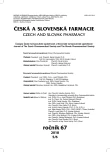
2018 Issue 5-6
Most read in this issue
- Beer with reduced carbohydrates and alcohol content suitable for diabetics
- Metal complexes in medicine and pharmacy – the past and the present I
- Co-processed excipients for direct compression of tablets
- Clinical pharmacist involvement in fall management in a polymorbid geriatric patient with a history of recurrent falls
